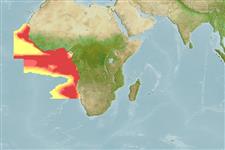>
Acropomatiformes (Oceanic basses) >
Synagropidae (Splitfin ocean-basses)
Etymology: Kaperangus: Name from the Russian 'kaperang', which is an abbreviation for the rank of captain required for long range oceanic cruises; dedicated to the crews of research vessels who have collected so many marine organisms for scientists.
More on author: Norman.
Environment: milieu / climate zone / depth range / distribution range
Ekologi
marina batypelagisk; djupintervall 50 - 500 m (Ref. 26999), usually ? - 200 m (Ref. 6916). Deep-water; 21°N - 24°S, 26°W - 15°E (Ref. 116586)
Eastern Atlantic: from Mauritania to Namibia.
Size / Vikt / Age
Maturity: Lm ? range ? - ? cm
Max length : 16.5 cm SL hane/ej könsbestämd; (Ref. 6916)
Short description
Bestämningsnycklar | Morfologi | Morfometri
Taggstrålar i ryggfenan (totalt) : 10; Mjukstrålar i ryggfenan (totalt) : 9; Taggstrålar i analfenan: 2; Mjukstrålar i analfenan: 9. Dark brownish dorsally, paler below.
Found over mud bottom (Ref. 26999). Most abundant at about 200 m (Ref. 6916). Feeds on pelagic crustaceans like euphausiids, mysids and decapods (Ref. 27637).
Life cycle and mating behavior
Könsmognad | Reproduktion | Lek | Ägg | Fecundity | Larver
Smith, C.L., 1990. Moronidae. p. 692-694. In J.C. Quero, J.C. Hureau, C. Karrer, A. Post and L. Saldanha (eds.) Check-list of the fishes of the eastern tropical Atlantic (CLOFETA). JNICT, Lisbon; SEI, Paris; and UNESCO, Paris. Vol. 2. (Ref. 6916)
IUCN Red List Status (Ref. 130435: Version 2024-2)
Threat to humans
Harmless
Human uses
Verktyg
Special reports
Download XML
Internet-källor
Estimates based on models
Preferred temperature (Ref.
123201): 12.4 - 14.2, mean 13.5 °C (based on 8 cells).
Phylogenetic diversity index (Ref.
82804): PD
50 = 1.0000 [Uniqueness, from 0.5 = low to 2.0 = high].
Bayesian length-weight: a=0.00977 (0.00436 - 0.02192), b=3.01 (2.81 - 3.21), in cm total length, based on LWR estimates for this (Sub)family-body shape (Ref.
93245).
Trofisk nivå (Ref.
69278): 3.2 ±0.37 se; based on food items.
Resiliens (Ref.
120179): Mellan, lägsta populationsfördubblingstid 1,4-4,4 år (Assuming tmax>3).
Fishing Vulnerability (Ref.
59153): Low vulnerability (10 of 100).
